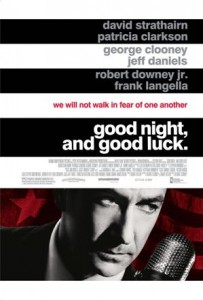 Good Night and Good Luck, directed by George Clooney, is the story of one critical moment in the modern history of the United States, in the newsroom and corporate offices of CBS, and in the life and career of broadcast journalist Edward R. Murrow. Murrow, who spent his entire career at CBS, achieved broadcast fame in World War II with his live radio reports of the London Blitz. In 1951 he moved into television, with the first broadcast of the program See It Now on November 18.
Good Night and Good Luck, directed by George Clooney, is the story of one critical moment in the modern history of the United States, in the newsroom and corporate offices of CBS, and in the life and career of broadcast journalist Edward R. Murrow. Murrow, who spent his entire career at CBS, achieved broadcast fame in World War II with his live radio reports of the London Blitz. In 1951 he moved into television, with the first broadcast of the program See It Now on November 18.
In the early 1950s, shortly after the onset of the Cold War, when certain demagogic politicians sniffed a communist under every bed, desk, and casting couch, one of the most bellicose of these politicians, the junior senator from Wisconsin, Joseph McCarthy, used his position as head of the Senate Permanent Subcommittee on Investigations to harass and falsely accuse witnesses called before that committee.
Alarmed by the effect on innocent people of McCarthy’s witch hunt, Morrow decided to take him on, obliquely at first but soon launching a frontal attack in a blistering editorial broadcast on 9 March, 1954, an editorial that rocked CBS, infuriated McCarthy and his fellow witch-hunters, and no doubt helped to turn the tide of public opinion against the excesses of McCarthyism. In the broadcast Murrow said of McCarthy: “It is necessary to investigate before legislating, but the line between investigating and persecuting is a very fine one, and the junior senator from Wisconsin has stepped over it repeatedly. We must not confuse dissent with disloyalty; we must remember always that accusation is not proof and that conviction depends upon evidence and due process of law.” As in all of his broadcasts, Murrow ends the program with the sign-off line “Good night, and good luck.”
Clooney’s film captures the drama of this moment in history in several ways. Good Night and Good Luck was shot in black and white in order to preserve the air of authenticity created by the film’s extensive use of archival newsreel and television footage from the period, including even a TV ad for Alcoa, the sponsor of See It Now and part of an interview with Liberace on the program Person to Person. Had the film been shot in colour and actors employed to play the roles of McCarthy, Roy Cohn, and accused communist sympathizer Annie Lee Moss, the illusion of being present in that moment would have been diminished and significant dramatic tension lost.
The action of the film takes place almost entirely in the studios and offices of CBS. Large numbers of writers, producers, technicians, and other support staff worked, often noisily and frenetically, in a cramped space to produce episodes of See It Now. The “normal” workplace tension is here exacerbated by the controversy, even danger, of Mr. Murrow’s piece on McCarthy. Clooney transmits this tension to the screen effectively through the extensive use of close-up shots and rapid camera movement.
David Strathairn is the perfect Murrow. Not only does he look and sound like the famous broadcaster, he is able to replicate Murrow’s mannerisms, including the characteristic cockeyed look into the camera. Strathairn’s Murrow is intense, passionate, and professional. Other cast members include Clooney as producer Fred Friendly, Frank Langella (outstanding) as CBS president William Paley, and Ray Wise, brilliant as the newsman Don Hollenbeck, frequently attacked by columnist and McCarthy supporter Jack O’Brian; depressed by O’Brian’s attacks and by the breakup of his marriage, Hollenbeck commits suicide in June 1954.
Behind the good looks (People’s Sexiest Man Alive for 2006) and roles in some pretty fluffy films, George Clooney has proven himself to be an actor of skill and substance (Syriana, Up in the Air, The Descendants). His work in Good Night and Good Luck demonstrates that he also has some pretty fine chops as a director.
Image Credit
Movie poster for Good Night and Good Luck from Wikipedia
Recent Ross Lonergan Articles:
- The Film-School Student Who Never Graduates: A Profile of Ang Lee, Part Four
- The Film-School Student Who Never Graduates: A Profile of Ang Lee, Part Three
- The Film-School Student Who Never Graduates: A Profile of Ang Lee, Part Two
- The Film-School Student Who Never Graduates: A Profile of Ang Lee, Part One
- Bullying, Fear, And The Full Moon (Part Four)


Please Share Your Thoughts - Leave A Comment!